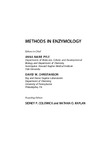Please use this identifier to cite or link to this item:
http://lib.hpu.edu.vn/handle/123456789/30427| Title: | Methods in Enzymology |
| Authors: | Pyle, Anna Marie Christianson, David W. |
| Keywords: | Enzymology Nano Technology |
| Issue Date: | 2017 |
| Publisher: | Elsevier |
| Abstract: | Enzymes are nature’s workhorses. These complex enzymes have a wide variety of essential roles in nature that include catalyzing reactions, transporting molecules, and DNA replication. Many studies in recent years have taken advantage of the specific properties of enzymes in order to design new materials and devices. There are many advantages of using an enzyme as the basis for a functional material: enzymes are highly specific to their substrates, they are biodegradable, and they have many functional groups on their surface, which can be chemically modified to tune the enzyme’s interactions with its environment. Compared to traditional organic synthesis reactions, enzymes are capable of catalyzing reactions in a more economic and green manner, and they also have very high activities and excellent selectivities. Enzymes, however, are often limited in their industrial and practical applications because of their poor stability—they are only stable in their physiological conditions (such as pH and temperature) and their poor recyclability and operational stability also limit their practical application. There are numerous methods developed over the decades to stabilize enzymes while maintaining their activity and selectivity. |
| URI: | https://lib.hpu.edu.vn/handle/123456789/30427 |
| ISBN: | 978-0-12-810502-3 |
| Appears in Collections: | Technology |
Files in This Item:
| File | Description | Size | Format | |
|---|---|---|---|---|
| Nano-Armoring-of-Enzymes-Rational-Design-of-Polymer-705.pdf Restricted Access | 27.93 MB | Adobe PDF |  View/Open Request a copy |
Items in DSpace are protected by copyright, with all rights reserved, unless otherwise indicated.
